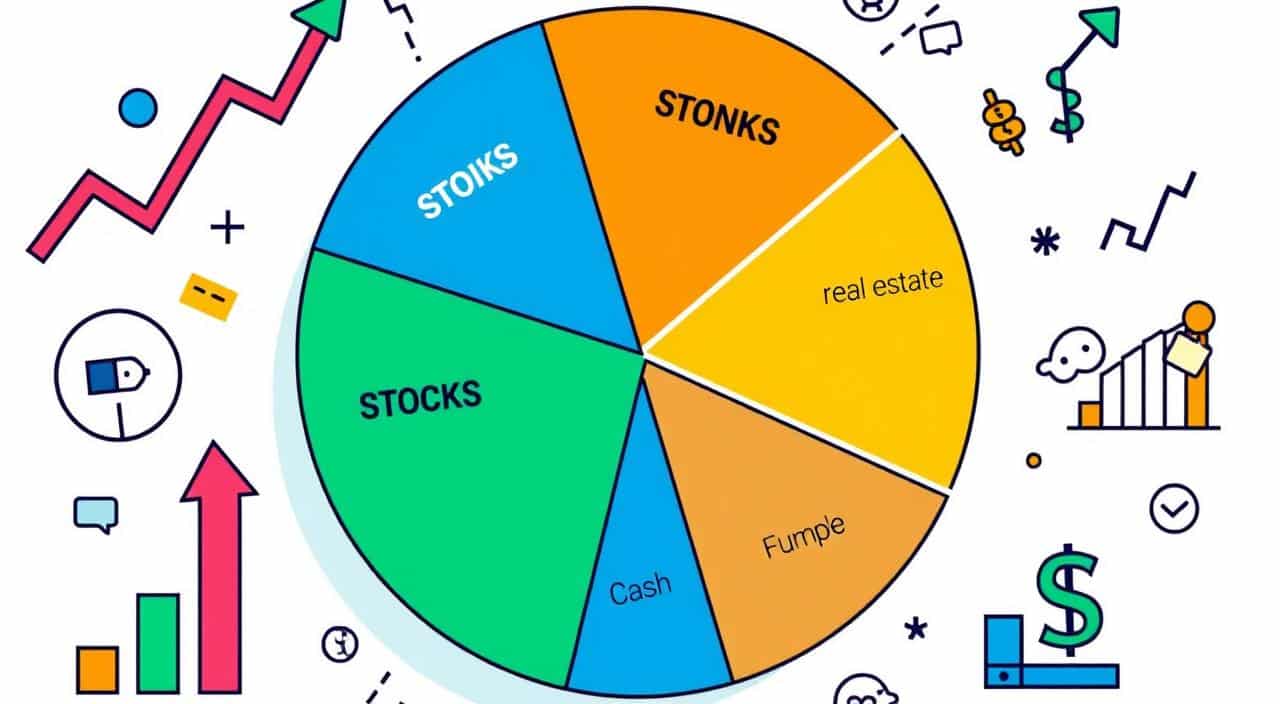In 2018, the federal government made about $170 billion from capital gains tax. It’s key to have a tax plan and know your tax exposure when investing. The capital gains tax rate depends on your income bracket and how long you owned the capital asset.
Long-term capital gains (assets held over a year) are taxed at 0%, 15%, or 20%. On the other hand, short-term capital gains (assets held under a year) are taxed like regular income. This can be up to 37%. Also, a 3.8% net investment income tax (NIIT) might apply if your income is above certain levels.
Key Takeaways
- Capital gains tax affects many investors through various investment transactions.
- Long-term capital gains are taxed at lower rates (0%, 15%, or 20%) than short-term gains (taxed at regular income tax rates).
- Figuring out the taxable capital gain involves complex factors like basis, exclusions, and special rules.
- Ways to lower capital gains tax include timing sales, using losses to offset gains, and tax-advantaged accounts.
- The American Families Plan proposes higher capital gains tax rates for the wealthy.
Understanding Capital Gains Tax
When you sell or trade a “capital asset”, like stocks, bonds, or real estate, you make a profit. This profit is called a capital gain. It’s usually taxed, but the tax rules depend on the asset and how long you’ve owned it.
What Is a Capital Gain?
A capital gain is the profit from selling a capital asset. It’s the difference between what you paid for it and what you sold it for. Capital assets include things like stocks, bonds, and even cars or homes you own.
When Are Capital Gains Taxed?
- Capital gains are taxed when you sell an asset, not just when its value goes up.
- Some exceptions apply, like if you’re forced to sell or if you swap one asset for another similar one.
- Business inventory is treated differently from other capital assets for tax purposes.
It’s key to understand capital gains tax to make smart choices and lower your taxes. The next part will cover how to figure out your taxable capital gains.
Calculating Taxable Capital Gain

Calculating the taxable capital gain from selling an asset starts with the “cost basis.” This is usually the original purchase price. But, it can get more complicated if the asset was inherited, given as a gift, or received as compensation.
How to Calculate Capital Gain Tax
To figure out the capital gain tax, you need to know the sale price and the cost basis. The taxable gain is the sale price minus the cost basis. You can also add expenses like buying, selling, or improving the asset to lower the gain.
Basis and Exclusions
- Certain exclusions, like the $250,000 ($500,000 for married couples) exclusion on primary residence sales, can reduce taxable gains.
- Qualified small business stock (QSBS) held over five years might get a 100% capital gains exclusion, up to a limit.
- Inherited assets often have a “stepped-up basis,” which is the asset’s value at the previous owner’s death. This can greatly reduce the taxable gain.
It’s important to understand the rules on cost basis and exclusions. This knowledge helps in reducing capital gains tax when selling different types of assets.
| Filing Status | Long-Term Capital Gains Tax Rate | Short-Term Capital Gains Tax Rate |
|---|---|---|
| Single | 0%, 15%, or 20% | 10% to 37% |
| Married Filing Jointly | 0%, 15%, or 20% | 10% to 37% |
| Head of Household | 0%, 15%, or 20% | 10% to 37% |
Getting the taxable capital gain right and knowing the tax rates and exclusions is key. It helps in reducing the tax on your investments and asset sales.
Capital Gains Tax Rates

Investments are affected by the capital gains tax. This tax rate changes based on if the gains are long-term or short-term.
Long-Term vs Short-Term Gains
Long-term capital gains happen when you hold assets over a year. These gains are taxed at a lower rate than short-term capital gains. Short-term gains occur when you hold assets for less than a year.
In 2023, the tax on most long-term capital gains is capped at 15%. If your income is below $44,625 for singles or $89,250 for couples, you pay 0% tax. For those with higher incomes, the rate goes up to 15% or 20% for the wealthiest.
Short-term capital gains, however, are taxed at your regular income tax rate. This can be as high as 37%. So, holding onto investments for more than a year can save you money in taxes.
High-income earners face an extra 3.8% net investment income tax on gains. This highlights the need for smart tax planning.
Capital Gains on Specific Assets

Capital gains taxes have special rules for certain assets. Knowing these rules helps investors and taxpayers make smart choices. It also helps them lower their taxes.
Collectibles and Real Estate
Collectibles like art, antiques, and precious metals face a 28% tax on long-term gains. This is higher than the usual 20% rate for other long-term gains.
Real estate taxes can be complex. Selling a personal home might get you a $250,000 ($500,000 for married couples) exclusion on capital gains. But, investment real estate faces “recapture” rules. This means a 25% tax on the gain from depreciation deductions.
Investment Property and Recapture
Investors with properties that have had depreciation deductions should know about “recapture” rules. The gain from these deductions is taxed at 25%, not the usual long-term rate. This tax ensures the deductions are properly taxed.
Understanding capital gains taxes on assets like collectibles, real estate, and investment properties is key. It helps taxpayers plan and reduce their taxes.
“Careful planning and professional guidance can help investors navigate the complex world of capital gains taxes and make the most of their investment opportunities.”
Capital Gains

As an investor, you have many ways to lower your capital gains taxes. One good method is tax-loss harvesting. This means selling losing investments to cut down on taxes owed on gains. It can balance your gains and losses, possibly lowering your tax bill.
Donating appreciated assets to charities is another smart move. It helps your favorite causes and lets you avoid capital gains taxes on those assets. Also, having a tax-diversified portfolio with different types of investments can help manage taxes over time.
If you run a small business, the Section 1202 exclusion might help. It lets you exclude up to $10 million of capital gains from certain stock sales. This can greatly reduce your taxes.
Good tax planning is key to handling capital gains taxes. A financial advisor or tax expert can help create a plan that fits your goals and risk level. This way, you can make the most of your investments while keeping taxes in check.
| Tax Strategy | Description | Potential Benefits |
|---|---|---|
| Tax-Loss Harvesting | Selling underperforming investments to offset capital gains | Reduces overall tax liability by balancing gains and losses |
| Charitable Donations | Donating appreciated assets to charitable organizations | Avoids capital gains taxes on donated assets and supports charitable causes |
| Tax-Diversified Portfolio | Investing in a mix of taxable, tax-deferred, and tax-exempt assets | Provides flexibility in managing tax liabilities over time |
| Section 1202 Exclusion | Exemption for capital gains from the sale of qualified small business stock | Reduces tax burden for entrepreneurs and small business owners |
Using these tax strategies and planning well can help manage your capital gains taxes. This way, you can keep more of your investment returns. It’s a step towards a more tax-diversified portfolio and reaching your financial goals.
Net Investment Income Tax

The net investment income tax (NIIT) is a big deal for many investors and high-income earners. It’s an extra 3.8% federal tax on investment income. This includes capital gains, for those making over certain income levels.
If your modified adjusted gross income (MAGI) is over $200,000 as a single filer or $250,000 for married couples, you’ll face this tax. The tax is based on the lesser of your net investment income or how much your MAGI is over the threshold.
Income like interest, dividends, capital gains, rental income, and passive activity income is taxed. This includes gains from selling stocks, mutual funds, real estate, partnerships, and S corporations, minus any losses.
But, some income is not taxed, like wages, most self-employment income, Social Security benefits, and qualified plan withdrawals. Also, selling a personal residence up to certain amounts is usually not taxed.
| Filing Status | MAGI Threshold | NIIT Rate |
|---|---|---|
| Single or Head of Household | $200,000 | 3.8% |
| Married Filing Jointly | $250,000 | 3.8% |
| Married Filing Separately | $125,000 | 3.8% |
To lower your NIIT, consider tax-advantaged plans, offsetting losses against gains, and increasing investment expense deductions. By managing your MAGI and net investment income, you can lessen this tax’s impact.
Reporting Capital Gains

Managing your investments means knowing how to report capital gains. The IRS has rules for this. They help you follow the law and save on taxes.
Accurately Reporting on Tax Returns
You must report capital gains and losses on your tax return each year. This includes both short-term and long-term gains and losses. Short-term sales are taxed like regular income, up to 37 percent in 2023. On the other hand, long-term assets get a lower tax rate of 0 percent, 15 percent, or 20 percent, based on your income.
To report gains and losses right, use Form 8949. It lists each transaction’s details, like the company name and sale dates. Then, summarize this on Schedule D of your tax return.
Utilizing Capital Losses and Carryforwards
Net capital loss can lower your taxes up to $3,000. Any losses left over can be carried forward to future years until used up. This helps offset future gains.
Keeping accurate records and following IRS rules is key. It ensures your capital gains and losses are reported correctly on your tax return.
Also Read : Setting Long Term Financial Goals For Success
“Properly reporting capital gains is crucial for maintaining compliance with IRS regulations and maximizing tax savings.”
Conclusion
Understanding capital gains tax is key for investors wanting to improve their strategies and cut down on taxes. Knowing the different tax rates, rules, and strategies helps investors make smart choices. These choices can help them reach their financial goals and lower their tax bill.
Looking into what affects capital gains taxes, like holding periods and asset types, helps investors plan better. Using tax-friendly investments, offsetting gains with losses, and using exemptions can also help. These steps can lessen the impact of capital gains taxes on their finances.
Knowing about capital gains tax can give investors important insights. It helps them include tax planning in their investment strategies. By staying informed and managing their taxes well, investors can achieve long-term success. They can also make the most of their investments.
FAQs
Q: What is the difference between long-term capital gain and short-term capital gain?
A: Long-term capital gain refers to profits from the sale of assets held for more than one year, which are typically taxed at a lower long-term capital gains tax rate. In contrast, short-term capital gain comes from assets held for one year or less and is taxed as ordinary income, subject to the individual’s federal income tax rate.
Q: How do capital gains taxes work in 2024?
A: In 2024, capital gains taxes are applied to the profit from the sale of assets. The tax rate on capital gains depends on whether the gain is classified as long-term or short-term. Long-term capital gains are generally taxed at a lower rate compared to short-term capital gains, which are taxed at the individual’s ordinary income tax rate.
Q: Do I need to pay capital gains tax if I reinvest my profits?
A: Yes, you still need to pay capital gains tax on realized capital gains, even if you reinvest your profits. The tax applies when you sell an asset for a profit, regardless of how you use the proceeds from that sale.
Q: What qualifies as a capital gain?
A: A capital gain qualifies as the profit you make when you sell an asset for more than its purchase price. This can include stocks, real estate, and other investments. Any realized capital gain may be subject to capital gains tax based on how long you held the asset.
Q: What is the long-term capital gains tax rate for 2024?
A: The long-term capital gains tax rate for 2024 varies depending on your income tax bracket. Typically, it can be 0%, 15%, or 20%, based on your total income and filing status as defined by the tax code.
Q: How does state tax affect capital gains taxes?
A: State tax on capital gains varies by state. Some states impose a separate capital gains tax, while others tax capital gains as part of your ordinary income. It’s important to consult your state tax laws or a tax advisor for specific details.
Q: Can I use losses to lower capital gains tax?
A: Yes, you can use capital losses to offset capital gains, which can help lower your overall capital gains tax liability. This process is known as tax-loss harvesting, where you strategically sell investments that have lost value to reduce your net capital gain.
Q: What happens if I owe capital gains taxes and don’t pay them?
A: If you owe capital gains taxes and fail to pay them, you may face penalties, interest charges, and collection actions from the IRS. It’s essential to file your tax return accurately and pay the tax owed to avoid these consequences.
Q: How do I report capital gains on my tax filing?
A: To report capital gains on your tax filing, you need to complete IRS Form 8949 for each sale and summarize the totals on Schedule D. This information is then reported on your individual income tax return, ensuring that you comply with federal tax regulations regarding capital gains.
Source Links
- https://www.kiplinger.com/taxes/capital-gains-tax/604943/what-is-capital-gains-tax
- https://www.empower.com/the-currency/money/long-term-capital-gains-tax
- https://www.cnb.com/personal-banking/insights/understanding-capital-gains-tax.html
- https://www.investopedia.com/terms/c/capital_gains_tax.asp
- https://www.finra.org/investors/insights/capital-gains-explained






